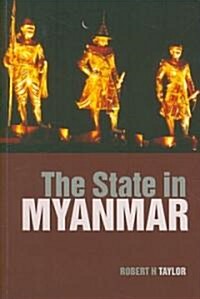
단행본
(The) state in Myanmar
- 개인저자
- Robert H. Taylor
- 발행사항
- Honolulu : University of Hawaiʻi Press, , 2009
- 형태사항
- xxv, 555 p. : : maps ; 23cm
- ISBN
- 9780824833626
- 청구기호
- 340.9145 T245s
- 서지주기
- Includes bibliographical references (p. 507-542) and index
소장정보
| 위치 | 등록번호 | 청구기호 / 출력 | 상태 | 반납예정일 |
|---|---|---|---|---|
이용 가능 (1) | ||||
| 1자료실 | 00014293 | 대출가능 | - | |
이용 가능 (1)
- 등록번호
- 00014293
- 상태/반납예정일
- 대출가능
- -
- 위치/청구기호(출력)
- 1자료실
책 소개
Statecraft in Myanmar, previously referred to as Burma, has a lineage going back ten centuries or more. While the state today is expected to provide many other services for a vastly larger population than were its pre-modern predecessors, its basic functions of maintaining order, controlling economic distribution, and ensuring the perpetuation of itself and its elite managers, remain much the same. The tools available now to do so may be different, and the challenges it faces may have grown, but the issues it addresses would be familiar to the predecessors of the modern rulers of Myanmar.
Myanmar, with its estimated population of about 55 million, the 24th largest country in the world, is larger than England. With a territory as big as Texas, it is wedged between the two of the oldest civilizations and now dynamic economies on the globe, India and China. Having been influenced by both India and China for centuries, Myanmar has developed its own cultural distinctiveness in contrast with its near neighbors in Southeast Asia, especially Thailand, Laos, Cambodia, and Vietnam. Once governed as a British Indian province, Myanmar emerged from the colonial era and the Second World War an economically devastated but strongly nationalistic socialist state. Riven since independence by armed ethnic and ideological conflicts that lasted most of the years between 1948 and the 1990s, when ceasefire agreements were reached with multiple insurgent armies, Myanmar's little-studied politics contain elements common to many countries. However, in few have the complexity of forces, historical and contemporary, religious and secular, foreign and indigenous, come together in one place to create so many little understood, and seemingly irresolvable, political issues. The State in Myanmar attempts to draw the complex history of state-making and state perpetuation in Myanmar in one volume. The social and economic forces, as well as international and domestic issues, which have made Myanmar one of the poorest and least understood Asian countries, are discussed. The efforts of Myanmar's kings, British colonial officials, nationalist politicians, socialist ideologues, and army generals to preserve the state in Myanmar is a history worth attempting to understand on its own terms.